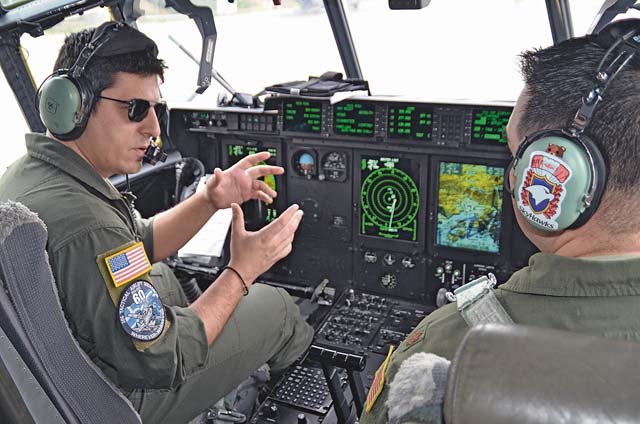
Greek Capt. Vasileios Mosios, 356th MTM (Tactical Transport Squadron) co-pilot, discusses the functions of a C-130J Super Hercules with Maj. Bill Tice, 37th Airlift Squadron instructor pilot, during Stolen Cerberus, a flight training deployment Feb. 2 to today designed to incorporate various training methods in order to maintain proficiency during deployed operations and increase interoperability with the Hellenic air force.
ELEFSIS, Greece — More than 150 Ramstein Airmen from the 86th Airlift Wing and 435th Air Ground Operations Wing, along with U.S. Army jumpmasters, participated in Stolen Cerberus, a two-week flight training deployment designed to incorporate various training methods to maintain proficiency during deployed operations from Feb. 2 to today.
The training mission brought U.S. and Greek military forces together to build upon and strengthen the bonds shared between the two countries, while continuing to improve interoperability as Greece and the U.S. continue to work together in operations worldwide.
“We are here to build partnerships while working with our Greek counterparts as we exchange airlift and airdrop tactics and ideas. Our trip here is vital to everyone involved,” said Maj. Jonathan Sumner, 37th Airlift Squadron deployed commander.
“We are able to train and maintain jump requirements during the day and complete our nighttime training requirements.”
According to Sumner, one of the most valuable aspects of Stolen Cerberus is the chance to work with their Hellenic Air Force counterparts. The chance to combine efforts with another nation and accomplish training together is invaluable and one of the reasons a mission like this is so effective.
“It has been very nice having the U.S. Air Force visit our base and our squadron,” said Hellenic air force Capt. Vasileios Mosios, 356th MTM (Tactical Transport Squadron) copilot. “It has been a great opportunity to see how the U.S. Air Force operates compared to how we operate. There are definitely differences in the way we perform operations.”
Mosios added that even though there are differences in each force’s operations and airframes, there are many similarities which make combined operations beneficial to both countries.
“Working with the U.S. Airmen has been very easy,” he said. “They have been very polite and cooperative. They work very hard, maybe a little too hard, but the opportunity to learn is very valuable to both nations, because it allows us to work better in future operations. We hope this is the beginning of more in-depth training with the U.S. forces.”
The combined training was not limited to 86th AW aircrews, 435th AGOW Airmen managing drop zones and Army jumpmasters assisting their Greek counterparts. It also incorporated several support elements, such as aircrew flight equipment. Master Sgt. Marittza Stewart, 86th Operations Support Squadron aircrew flight equipment flight chief, said she is very happy to be able to learn and share with the Greek.
“I really enjoy working with the Greeks; they are very professional,” she said. “The opportunity to train with our NATO partners allows both nations the chance to understand how we operate, while we learn how they operate. It has been great getting to know everyone here, as we continue build upon our interoperability for possible future joint operations.”


